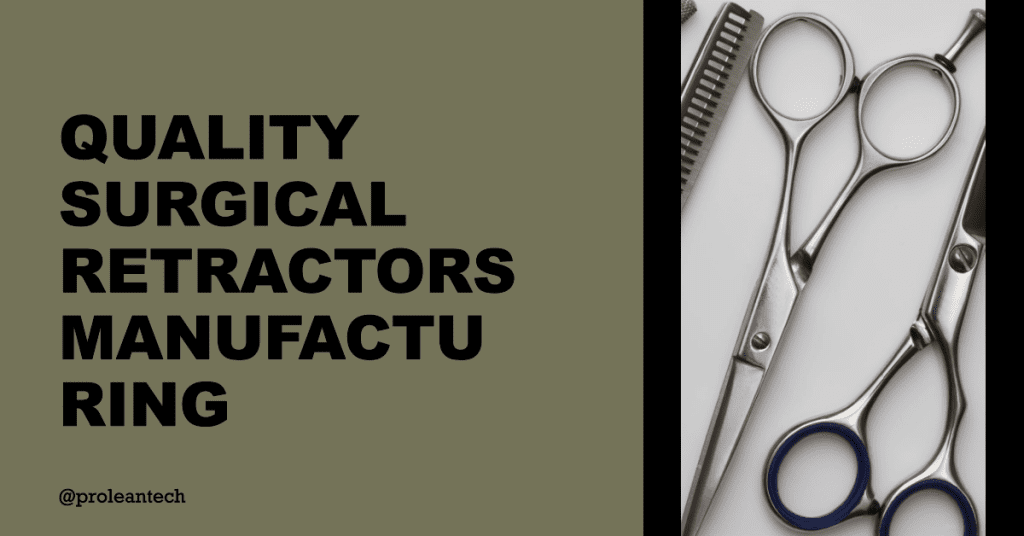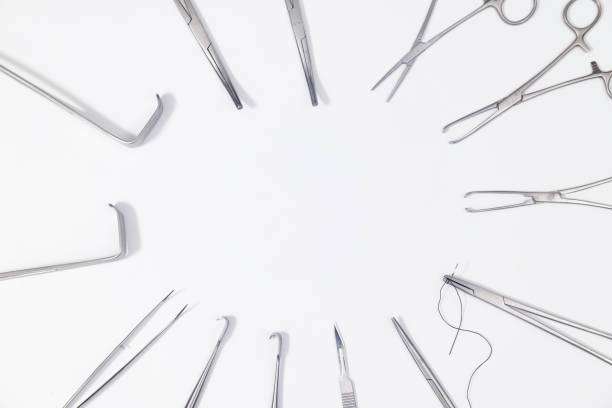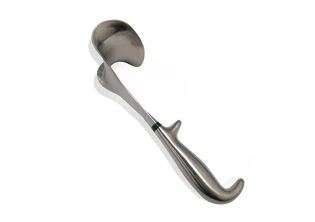
The field of medical manufacturing is characterized by precision, stringency, and innovation. Surgical instruments are at the heart of this field, and their manufacturing demands not just accuracy but also a high degree of complexity. Among the various processes involved, deep drawing stands out as a vital method for shaping these critical tools.
This article explores a case study showcasing the impactful role of deep drawing in surgical instrument manufacturing.
I. Background and Challenges
Understanding the Retractor

Surgical instruments on white background,top view
Deep-drawn surgical retractors
A surgical retractor is a device that surgeons use to separate the edges of a surgical incision or wound or to hold back underlying organs and tissues, so that body parts under the incision may be accessed. It is a simple yet crucial instrument for any surgical procedure.
Retractors come in various shapes and sizes, each designed for a specific surgical context. Some retractors are handheld, allowing surgeons to adjust their position and force as required. Others are self-retaining, allowing hands-free operation after placement. Some common types of retractors include the Army-Navy, Senn, and Rake retractors.
The given table summarizes some common types of retractors and their primary applications:
| Retractor Type | Primary Use |
|---|---|
| Army-Navy | General-purpose retractor; often used in shallow incisions |
| Senn | Typically used in neurosurgery or ophthalmic procedures |
| Rake | Often used in orthopedic procedures or large incisions |
The Need for a New Approach
The manufacturing of surgical retractors poses several challenges. Because of their application in critical medical procedures, these instruments must be crafted with extreme precision and excellent surface finish to minimize patient discomfort and avoid complications. They also need to withstand high stress without deforming and must resist corrosion, even after repeated sterilizations.
Traditionally, surgical retractors were made using techniques like forging and machining, followed by extensive manual finishing processes such as grinding and polishing. This traditional manufacturing approach presents several issues:
- Inconsistencies: Manual finishing processes can result in variances between individual tools, which may affect their fit and performance during surgery.
- Low production efficiency: Traditional manufacturing methods are labor-intensive and time-consuming, making them unsuitable for large-scale production.
- High costs: The extensive manual labor involved in traditional processes results in high manufacturing costs.
These challenges have driven the search for new, more efficient manufacturing methods. One such method that has demonstrated great potential is the deep drawing process, a type of sheet metal forming that can produce complex three-dimensional shapes with high precision and consistency.
II. The Deep-Drawing Solution
Deep drawing, as a solution for the manufacturing of surgical retractors, required careful design and planning. This is because the deep-drawing process involves a multitude of factors such as the choice of material, the design of the die and punch, the press capacity, the lubrication process, and the control of blank holder pressure.
| Step | Key Aspects |
|---|---|
| Choice of Material | Selection of suitable material like 316L Stainless Steel |
| Designing the Die and Punch | Using CAD and CAM tools for precise design |
| Press Capacity and Control of Blank Holder Pressure | Precise control to prevent defects |
| Setting Up the Deep-Drawing Press | Installation and adjustment of die and punch press operation |
| Running the First Batch | Inspection of the first batch for quality control |
1. Choice of Material
The choice of material is fundamental in the process of deep drawing. Surgical retractors need to be manufactured from materials that are bio-compatible, corrosion-resistant, and capable of being sterilized. Stainless steel, particularly grades like 316L, is a common choice due to its excellent mechanical properties, corrosion resistance, and bio-compatibility.
2. Designing the Die and Punch
Designing the die and punch is the next critical step. It’s important that the die and punch are precisely designed and machined to achieve the desired shape of the retractor. Computer-aided design (CAD) and computer-aided manufacturing (CAM) tools are often employed for this purpose.
3. Press Capacity and Control of Blank Holder Pressure
The press capacity and control of blank holder pressure is a crucial aspects of the process. The deep-drawing process must be controlled meticulously to prevent defects such as wrinkling, tearing, or thinning of the material.
4. Setting Up the Deep-Drawing Press
After the design process, the next step is setting up the deep-drawing press. This involves installing the die and punches in the press, adjusting the blank holder pressure, and ensuring that the press is operating smoothly.
5. Running the First Batch
The first batch of retractors is then produced. It is important to carefully inspect the first batch to ensure that the deep-drawing process is working as expected. This might involve measuring the parts for dimensional accuracy, inspecting for defects, and perhaps even testing a few parts in a simulated surgical environment.
Try Prolean Now!
III. Results and Insights

Surgical retractor created with Deep-drawing
As the new deep-drawing solution was implemented, the process was closely monitored to assess the effectiveness of this approach.
1. Outcome of the Project
- High-Quality Production
Through the deep-drawing process, the surgical retractors were successfully manufactured with high precision and excellent quality. The deep-drawing technique allowed for efficient mass production while maintaining the stringent requirements of the medical field. The produced retractors were dimensionally accurate, free from defects, and met the stringent sterilization requirements.
- Increased Efficiency and Cost-Effectiveness
The implementation of the deep-drawing process led to a notable increase in manufacturing efficiency. This translated to reduced production times, leading to a significant reduction in manufacturing costs. The use of deep drawing also minimized material waste, contributing to both cost savings and sustainability.
2. Key Learnings
- Importance of Accurate Die and Punch Design
One of the key learnings from this project was the importance of accurate die and punch design in deep drawing. Any inaccuracies in the die and punch design can lead to defects in the final product, requiring careful attention to detail in the design process.
- The Critical Role of Quality Control
Another important learning was the critical role of quality control. Despite the automation of the deep-drawing process, there’s a need for constant monitoring and control to ensure the production of high-quality, defect-free surgical retractors.
| Outcome | Insight |
|---|---|
| High-Quality Production | The deep-drawing process led to the production of high-quality surgical retractors |
| Increased Efficiency | The implementation of the deep-drawing process led to increased manufacturing efficiency |
| Cost-Effectiveness | The deep-drawing process led to significant cost savings, primarily through reduced production times and minimized waste |
| Importance of Accurate Die and Punch Design | Precise design of the die and punch is critical to the success of the deep-drawing process |
| Critical Role of Quality Control | Despite automation, constant monitoring and control are necessary to ensure high-quality production |
Summing Up
The process of deep drawing, as explored through the manufacturing of a surgical retractor, illustrates the immense potential of this sheet metal forming technique. From increased efficiency and cost-effectiveness to high-quality and precise production, deep drawing has proven its worth in the manufacturing landscape. In particular, its application in the medical field, with its stringent requirements, highlights the versatility and precision of this technique.
At the end of this journey, Prolean’s deep-drawing and other metal-forming services have once again proven their reliability and precision in the metal-forming industry. The successful production of surgical retractors, compliant with stringent medical requirements, is a testament to our expertise in deep drawing and capabilities in this field. For those seeking solutions for their metal forming needs, Prolean offers a wide range of services beyond deep drawing, ensuring that the specific requirements of any project can be met with precision and efficiency.
FAQ’s
1. What is deep drawing and how was it applied in the production of surgical retractors?
Deep drawing is a metal-forming process where a sheet of metal, known as a blank, is formed into a depth greater than its diameter. For the surgical retractors, a deep drawing process was designed and implemented, allowing for the mass production of high-quality retractors.
2. How did the deep-drawing process improve manufacturing efficiency?
The deep-drawing process increased manufacturing efficiency by reducing production times and minimizing material waste. This resulted in significant cost savings.
3. What were the key learnings from this case study?
The critical importance of accurate die and punch design, as well as quality control, were key learnings from this case study. These factors were essential to ensuring the production of high-quality, defect-free surgical retractors.
4. What challenges were encountered in the manufacturing process?
The main challenge was meeting the stringent requirements of the medical field, such as dimensional accuracy and sterilization compatibility. These were successfully met through careful process design and stringent quality control.
6. How was quality control ensured in the deep-drawing process?
Despite the automation of the deep-drawing process, there was a need for constant monitoring and control to ensure the production of high-quality, defect-free surgical retractors. This quality control was integral to the success of the project.




0 Comments